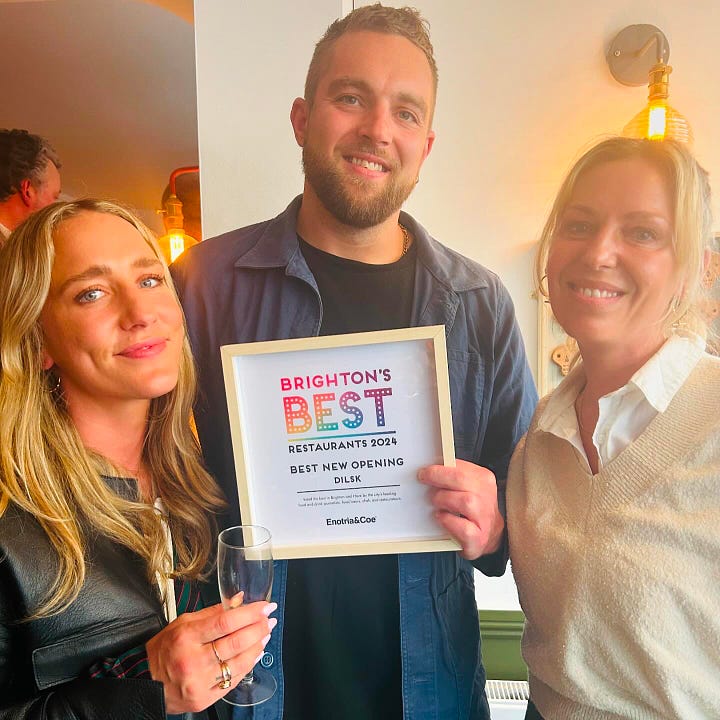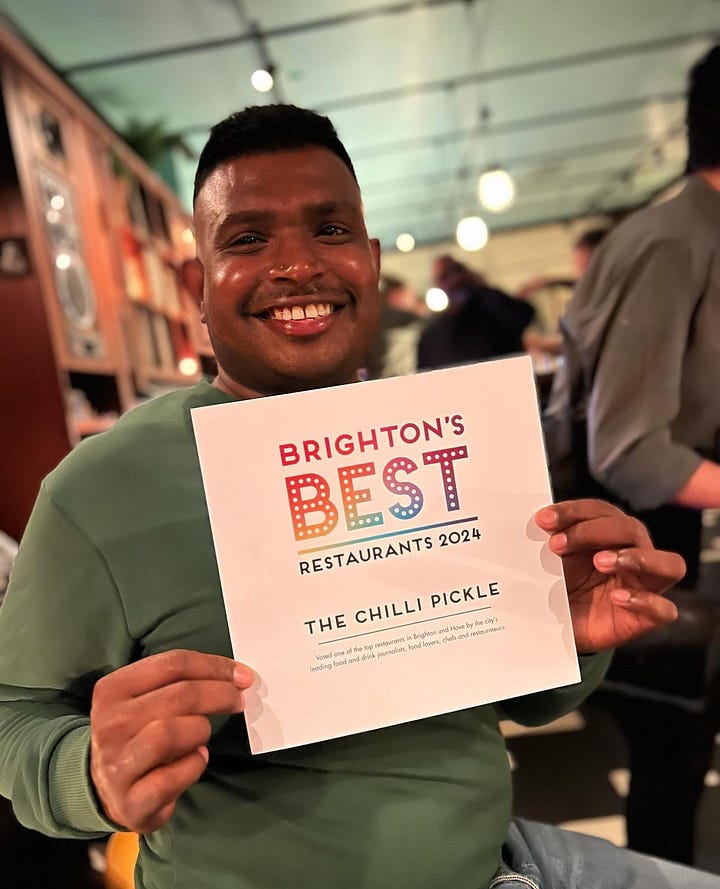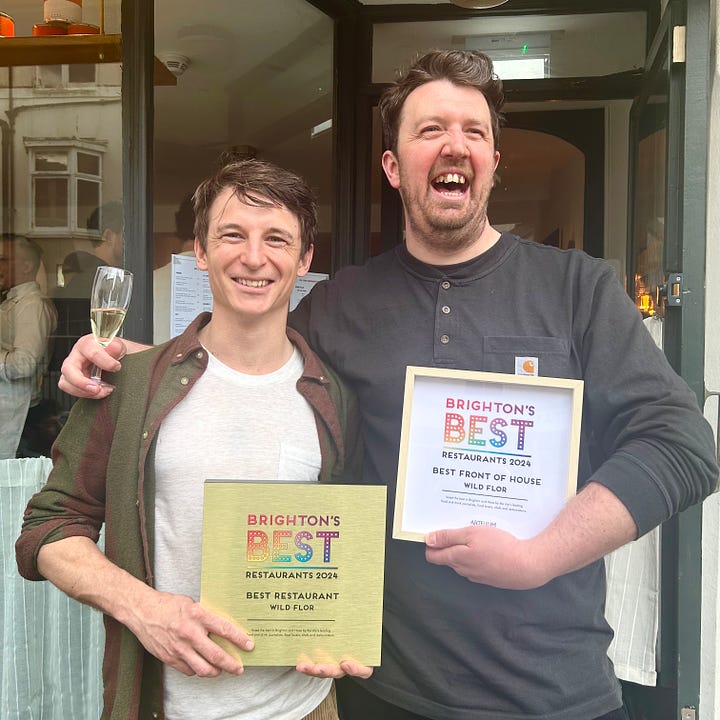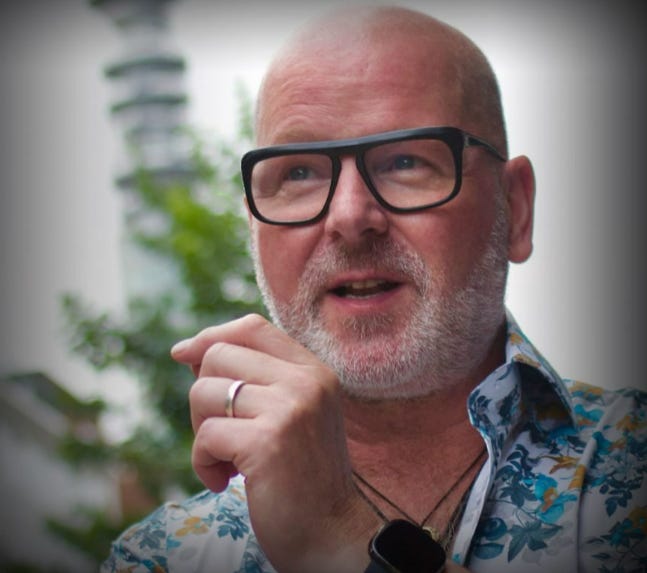Before we get stuck into this special edition of Smashed dedicated to the art of drinking wine (stand easy restaurant critics. You’ll be back on parade soon), a couple of bits of news from my food and drink life.




On Monday, it was finally the big reveal of the 8th annual Brighton’s Best Restaurant awards which I seemed to have been working on since the dawn of time and co-founded with my chums the cheese writer Patrick McGuigan, PR and marketing whiz Suzanne Linsfors and Euan MacDonald who has recently become a restaurateur himself by opening the marvellous No No Please, where we held the awards. It was awfully convivial and then everyone got massively pissed courtesy of Permit Room. Thanks guys! BRIGHTONTHEINSIDE gave the event a nice write up and you can read all about the award winners and the list of Brighton’s Best Restaurants on our new website. Look at their happy smiling faces. Doesn’t it just make your heart glad?
I was invited to be a guest on chef Andrew Dargue’s highly entertaining food-themed podcast Vanilla Black Radio, named after his former London restaurant. You can listen via the player below. Andrew says its a good episode but I cannot bear the sound of my own voice so I haven’t heard it myself. If you enjoy it please follow and share the link. If you don’t like it, please don’t tell me.
The Smashed guide to drinking wine in restaurants





Are you confused by restaurant wine lists? Of course you are. Do you panic, point at the first thing that you vaguely recognise and hope it’s OK? Of course you do. Wine is a massive subject. About 18 million acres of the earth’s surface is vineyards and wine is made everywhere from Norway to Central Otago in New Zealand and from California to Yamanashi Prefecture in Japan. People spend years studying to become a Master of Wine of which there are currently only 417 in the entire world. For most of us, there is simply too much to learn and not enough time.
With the price of wine in restaurants on the rise (in a quality restaurant, you will be lucky to find much choice under £50) a little wine knowledge will go a long way to ensure you get the best value for money on a night out. I spoke to five industry experts to get insights into how to navigate a restaurant wine list to avoid costly mistakes and hunt out the best value every time.
Douglas Blyde (DB) is a wine columnist, critic, consultant and presenter and writes regularly for the Evening Standard and Drinks Business. Matthew Davison (MD) is the sommelier at two Michelin-starred restaurant with rooms Moor Hall in Aughton. Tom Gilbey (TG) has 128k followers for his highly entertaining and informative Instagram account (@tomgilbeywine). He is a wine event organiser and sells wine through his website tomgilbey.com. Tom Fahey (TF) is owner and chef of The Terrace Rooms and Wine boutique hotel, restaurant and wine shop. David Moore (DM) is the owner of the Michelin starred Pied a Terre in London which boasts one of the best wine lists in the city.
What are some of the tell-tale signs of a good wine list?
TF: Many casual-dining lists are put together by a single supplier to tick the predictable pinot grigio, Argentine malbec, NZ sauvignon blanc, Provence rose boxes. They will usually contain mass-produced, bulk wines sold to countless other pubs and restaurants and are designed for guests who just want to order a wine they recognise without too much trouble, so I would look for wines I don’t recognise. Any list that has older wines is usually going to be the product of higher-effort buying. A big, multi page list with a lot of wines you feel able to afford is very likely to be good over a small one filled with wines you can’t stump up for.
DB: I like to see lots of attainably priced bin-ends with age rather than long, untouchably expensive compendiums. Also, lists tended to by long-standing sommeliers, who are experts in their venue and its clientele, tend to have more coherence than those that have been subject to a pinball-like procession of wine people who have each tried to make their mark, leaving behind confusion.
MD: Accessibility and navigation are key, we have recently moved from our wine list being on a tablet, to a printed copy, and we have found it has endlessly improved our guest experience in terms of being able to navigate it very easily. In terms of accessibility, a great list needs to showcase a breadth of price points to suit as many as possible, but I also find that having a really strong by the glass selection from a variety of producers is essential so for those who don’t necessarily want to drink/require a bottle, having a couple of interesting glasses can be just as, if not more exciting.
Should I trust the sommelier? Aren’t they just going to try and sell me a more expensive wine that I had planned to buy?
TG: if you've got a massive wine list and you're in an expensive restaurant for goodness sake, don't do it yourself. Get the help of the sommelier and give them really clear instructions; for example, that you are not allowed to spend more than £50 and you want the full bodied red. Don't be afraid, treat them like estate agents or car salesmen. Don't let them have one over on you. You are the boss, tell them what you want and they'll do a good job.
DM: A sommelier should be approachable. A good sommelier will warm to you instantly and is able to translate your garbled comments about you've recently had and enjoyed into a bottle that he thinks you will love. An interesting sommelier will want to surprise you. Tell them, ‘I would normally have something like a Sancerre, do you have something more interesting at that sort of price point?’ I do think you have to actually say that that's your price point. Not every sommelier is as straightforward as ours, and the upsell is part of their job.
I’ve been served a bottle and I think it might be corked, what do I do?
DM: Unless a wine it is blatantly wrong, and you know what you're talking about, I find the phrase, ‘Is this as you would want it to be, or is this as you would expect it to be’, offering the sommelier to have a taste of it is like a get out of jail free card. You're not piping up and saying the wine's wrong, you're not showing any ignorance. If the sommelier is any good, he should explain what it is that you're tasting.
Should I always avoid the house wine?
DM: You judge a restaurant by its quality of house wine. If you are in a good restaurant that actually does have a sommelier, and if he does have a house wine, then it's got to be good.
TF: In wine-orientated restaurants the house wine is likely to be very good. In more mainstream, everyday establishments where wine is just one element of a casual meal, the house is often chosen simply to achieve a price point. If you’re into wine I’d imagine you’ll avoid it regardless as it’s unlikely to be the most interesting thing on a list. If you’re strapped and want the cheap option just ask for a taste before you buy – house wines are almost always on by the glass so it shouldn’t be an issue.
DB: Synonymous with the cheapest bottle, it is probably best avoided unless the restaurant has worked collaboratively with a producer, as evidenced by chef Angela Hartnett and Tenuta Fertuna in Tuscany, for example.
MD: I think the term ‘house wine’ has such negative connotations, but I genuinely feel it depends on the establishment that you’re expecting to dine/drink in. You could, in theory, suggest that our ‘house wines’ at Moor Hall are the list of wines that we serve by the glass, but I would never use that term to describe them due to the aforementioned negative reference. If you’re visiting a wine-led establishment then there should be nothing to avoid at all. Then I still think you have to think about the mood you might be in. If a guest is looking for a fresh glass of dry white on a sunny afternoon, or a robust juicy red to contemplate a hard day at the office, and they don’t want to spend a fortune, then why not. Wine is always to be enjoyed and explored.
TG: I think you should always order the house wine, because the house wine is the benchmark for any decent restaurant. I would never order the Prosecco. And the reason I wouldn't order this is because they're generally overpriced for what they are and not particularly exciting. And on the white wine, I'd never order the first sauvignon blanc on the wine list, whether it's New Zealand or France. I'd never order the pinot grigio and I would never order the Argentinian malbec. A really good wine list will have good versions of all of those wines.
People say the second cheapest wine on the list is where restaurateurs put their worst value wine because it’s what people who don’t want to look like cheapskates by ordering the house wine will go for. Is that true?
TF: No this isn’t remotely true. The real battle is trying to find something that isn’t pigswill for the cheapest wine because it’s the entry point and a real tone-setter for how consumers perceive your restaurant. Second cheapest – for me anyway – isn’t something I give any more thought to than the fifth, tenth or fiftieth cheapest.
DB: I suspect the British tend not to worry too much about looking miserly, given their fondness for sharing a starter, avoiding pudding, and opting for tap water. I tend to order by the glass these days, which gives a wider experience, rather than opting for a one-size-fits-all bottle, wherever it comes from in the list. The by-the-glass list should always be a window into the wider list and filled with interest.
DM: it's not an industry thing to have your biggest markup on the second cheapest wine however the best value tends to be in the more expensive bottles where you're not looking at a three or four times markup, but you're looking for a cash return. So a bottle that costs me, say £75 is on the list for £190; that's only two and a bit times but it gives me a bit of cash.
MD: I think this entirely depends on where you are drinking. I dare say that there may be some chain restaurants/bars which use this tactic, but I definitely think that it is less commonly seen now. As a nation we’ve become a lot more discerning about what we are drinking. More people care about how the grapes are grown and how the wine is made. We are constantly seeking great value and honest advice. I certainly wouldn’t be scared of ordering whatever I fancied these days. Nobody should ever feel judged about what they choose from a wine list, after all, it’s a vessel for enjoyment and creating conversation, and I think snobby perception of the industry is finally making its way out.
Why is sparkling wine only ever served by the glass as 125ml (or 100ml) and never 175ml?
MD: I suppose broadly speaking, most places serve their sparkling wines in flutes, so logistically a smaller measure works. There’s also the cost involved, sparkling wines and champagne carry a higher price point in general due to the production methods involved, amongst other things, so a smaller measure (should) amount to a smaller cost to the consumer, making sparkling wines more approachable. I guess after that, the larger the glass, the longer (in theory) it’s in there for, and could potentially lose its fizz over the period and most ordering a glass for a celebratory occasion want something with mousse and vibrancy. I’m yet to meet my first guest who requests a flat glass of Champagne.
I am a wine idiot and I only drink 19 Crimes, prosecco and cheap sauvignon blanc, but I want to change. What are some grape varieties I could look for on a wine list that I haven’t had before that would be easy for me to enjoy and appreciate?
TF: Basically you like wines with high sugar content because this masks both acidity and tannin. Try to find full bodied red wines with comparatively low tannin and whites with a bit of residual sugar. I’d suggest rhone valley wines with a high proportion of Grenache and some age - Gigondas or Chateauneuf de pape if you have the budget, or older Rasteau or Vacqueyras if you don’t. Older Cru Bourgeois Bordeaux is another good bet – wines with this classification are generally a bargain compared to the classified growths. If you get the right ones the tannins should have mellowed while the fruit hangs on. For whites, try a demi-sec Vouvray or German Kabinett under 11% alcohol. Another gateway wine out of cheap plonk is Asti, and a final one is New Zealand sauvignon, I think possibly because of the huge fruit content.
DB: Contrary to what you might have encountered, there are some excellent bottles from the land of Prosecco, including the vintage, handmade, single vineyard, Grave di Stecca by Nino Franco. Meanwhile, Gavin Quinney makes an excellent, bright sauvignon blanc and luxurious sauvignon/sémillon at Château Bauduc in Bordeaux for around £12 apiece (retail) – plus you can go and stay at the property and sip it by the swimming pool.
MD: For sparkling, there is an abundance of fantastic value English sparkling wines and Cremants are making their way onto lists all around the country. We work with Gusbourne in Kent, and despite being made in the same way as wines from Champagne, their chardonnay based sparklers are racy and fresh. To stretch further afield, try Sekt from Germany and you’ll also find amazing sparkling wines from Tasmania.
Moving away from Sauvignon blanc is never easy for the die hard Marlborough and Sancerre lovers, however, try looking at the mineral styles of assrytiko from Santorini, roditis from Greece or a beautiful gruner veltliner from Austria. If you’re seeking further obscurity, Carricante from Sicily is wonderful as is verdejo from Spain – whilst these are much more commonplace now, they are wonderful alternatives.
For the bolder, juicier Malbec enthusiasts, try some aglianico from southern Italy, these are intense and robust, or some spicy blaufrankisch from Austria, these should do the job just as well. Portugal is still shaking a reputation for some of their tannic reds, but the Douro Valley is producing some outstanding quality wines worth seeking out as an alternative too.

What regions around the world should I look at first on a list to find the best value for money at the moment (red and white)?
TG: I think the best countries to get really good value white wine on a wine list are Portugal and South Africa. For red, I love Italy because they're really good value. Southern Italy, nero d’avola, primitivo, generally anything from Sicily. I also look at Portugal for reds too. They're old world wines that generally go well with food rather than alcoholic fruit juice. I'd avoid a South African shiraz if it's cheap because it would taste like blackcurrant jam. Whereas a South African syrah that's a little bit more expensive will probably be a beautiful wine. Here's a massive generalisation, but if a red wine calls itself a shiraz, I wouldn't go for it. If it calls itself syrah I probably would go for it.
TF: For red it is still very hard to buy a truly bad Rioja at any price point – the classification system guarantees some age which, when you consider the implication of holding wine that could be sold back in a cellar, is worth a great deal. For whites Italy can be superb value if you want something simple and fresh. I sell a lot of organic grillo and catarratto from Sicily that has no business being as affordable as it is.
DB: England, not only for world-class sparkling wines, such as Hundred Hills, which crafts, by hand, single parcel sparkling wines but also this country’s still wines. I love Devon Millow, for example, an almost tropical, barrel-aged Bacchus created by chef Mark Hix and his fishing buddy, Robin Hutson - the founder of The Pig collection. Hungary has impressed me for good value reds, including the handsome Kovács Nimród Monopole 777 Pinot Noir encountered at The Devonshire.
MD: Some of the best value whites I have tasted recently have been from Greece and Sicily, there is so much diversity in some of the indigenous varieties here. I love Austrian all Austrian wines, and some of the reds made here make for remarkable value. Also tasted some fantastic wine from Northern Spain made with the Mencia grape.
DM: I usually head to the Loire Valley. I would stay away from Southern hemisphere sauvignon blanc for instance, I only really want to drink something that's maybe Touraine sauvignon Pouilly Fume or Sancerre. I always think you find value in the regions of France. You'll find also maybe more bottle age as well in an area where it's not so popular, it's maybe sat on the wine list like a nice Corbières. If I see a Limoux Crémant or a Limoux chardonnay, you’re pretty much guaranteed good quality wine making.
I love white Burgundy but I’m not made of money, what’s a cheaper alternative that would hit the spot?
TF: New Zealand chardonnay. Typically the style is crisp and light with buttery, smoky elements really subtle and well integrated. My favourites for value are currently are Kumeu River, particularly if you can find an older bottle of one of the single vineyard sites, Alex Craighead’s Don Barn Block, Michel Seresin’s Chardonnay or for something bigger, Matawhero Church House Chardonnay from Nelson is fantastic.
MD: Look to Oregon. The chardonnays and pinots are often made in a traditional Burgundian style in mind, and the quality here is generally exceptional across the board. Yarra Valley in Australia also has many fantastic producers and would be my next choice.
TG: I would try and get one that's slightly lesser known like Viré-Clessé or a Mâcon-Azé or a Mâcon Solutre - villages rather than a straightforward Macon Village. It would probably be a really, really good wine. It would indicate to me that the person who's put that wine list together knows what they're doing. Whereas if it’s a straightforward Pouilly-Fuissé or Chablis, that's going to be a margin trap. Alternatively, I would go for a well made chardonnay from South Africa or, and this is a little bit off piste because it's not a chardonnay, I'd go for a white Rhone; a really good Crozes-Hermitage white or a even a Côtes du Rhône white, that ticks a lot of the same boxes for me as a white burgundy.
I love red Bordeaux but I’m not made of money, what’s a cheaper alternative that would hit the spot?
TF: Our top alternative to this is Ram Paddock Red, an incredible Bordeaux blend from Wairapa in New Zealand which we currently have in the 2014 vintage. More generally I’d look to South Africa as they do the blends well. Morgenster’s Louren’s River Valley and Napier’s Red Medallion blow equivalently priced Bordeaux away for my money.
DB: Mature Cahors from south west France, which is where Malbec has been made since Roman times. I often see tempting renditions lurking on wine lists.
MD: Cabernet/merlot based blends can be found throughout the world, Hawke’s bay, NZ, have some amazing examples, as does Washington State in the US – and will always provide great value for money against Bordeaux.
TG: I'd probably go to Italy and see if they've got something there that's interesting - cabernet, merlot, maybe sangiovese, that kind of thing. That would be a delicious glass of wine with whatever I've chosen because I would hope it would have that sort of rusticity that I want from a red Bordeaux. I would be trying to find a big and chewy wine. Whereas if you said red burgundy, it's always very expensive and if it's not expensive, it's generally crap, but I would happily go with pinot noir from New Zealand, South Africa or maybe even the States, (although it'll probably be very expensive) or cool climate Australia. But Cabernet, it tastes very, very different from anything made in Bordeaux, wherever it comes from.

I am actually made of money/it’s a special occasion. I am fairly adventurous, what wines should I splurge on that will deliver for the money?
TF: Santorini assyrtiko is incredibly interesting, universally high quality and delicious.
Chablis has gone up a lot but Premier Cru from a good, emerging producer like Samuel Billaud, or someone underrated like Gilbert Picq or Domaine Pinson is always going to be special. If you want something from the UK buy Hundred Hills. For me it has the most significant, most distinct flavour differential.
DB: If this were me, I would prefer to hire a chef to come to my mansion to create a menu perfectly dovetailing with the bottles which I had collected at release/retail price, rather than see my fortune lost on hyper marked up restaurant bottles. It is quite common to see bottles on wine lists in London which are so expensive that it might be cheaper and more enjoyable to instead spend the same money on a first-class return flight to the origin of the bottle you are interested in and take a private tour and tasting at the winery.
MD: When splurging, it’s always worth keeping an eye on the vintages that you’re looking to buy from. If you are just looking to spend, be wary of the expensive Amarone’s that are less than ten years old, or your Bordeauxs and Burgundies from poorer years – despite coming from a well known chateau, or a well known village (Meursault/Puligny Montrachet for example), choosing something too young, or from a not so great year can leave you feeling quite underwhelmed. There are some producers however, that can consistently deliver.
A couple of examples I was lucky enough to try recently, that I would happily splurge on were Leeuwin Estate’s ‘Art Series’ Chardonnay from 2012, and Vega Sicilia’s ‘Valbuena No.5’ from 2014, the latter I thought was going to be far too young, but it was singing.
TG: I would go for a Super Tuscan. I'd always look to see if there is a Tignanello that's priced really well. I went into a pub the other day and saw a chateau lagrange 2009 from Bordeaux on a wine list for £90. That's a lot of money, but for that wine, it's not a lot of money at all. I'd be really wary of Burgundy unless I absolutely know the grower or there’s a really good sommelier because otherwise it’s Russian roulette.
I like classically made wines. Are there any regions or producers that I should look for on a list of all natural wines that are more likely to appeal to me?
TF: I’d stick to classically made wines assuming you like them but if forced into it, these are some bigger-name producers of relatively classical wines likely to end up on lists pitched as featuring low intervention styles: Sylvain Pataille for Burgundy, Jean Foillard for Beaujolais, Josmeyer for Alsace, A&O DeMoor for Chablis and Auxerre, Forjas del Salnés for Alberino.
MD: I think there are some producers like Judith Beck (Austria) and Clemens Busch (Germany) which have some styles they make which are more classically driven, but made in a more hands off style. Foradori (Italy) make exceptional wines from local grapes too, also Henri Milan in Provence (France) makes some of the most delicious Burgundian style wines with grenache and syrah I’ve tasted. Whitcraft winery in the USA will not disappoint.
I now want to embrace natural wines - what are the really out-there producers I should look for on a wine list.
MD: There are many ‘cult’ producers and growers out there now, but the ones that I have been exposed to that I think are worth noting are Christian Tschida, Radikon, Gravner, Robinot, Gut Oggau and Frank Cornelissen.
TF: I don’t know if any of these producers are considered “out there” but they’re certainly names in the world of natural wine making that will deliver a style the average drinker might consider odd, funky or even faulty. Gut Oggau, Pheasant’s Tears, Tillingham, Brett Brothers, Radikon, Chateaux Le Puy. To be honest, though, if you want to embrace “natural” wine you will have a very easy time of it in any bar or restaurant that favours the style. The harder task is finding bottles that might not be seen as faulty, odd or “like cider” by the average drinker.
DB: What is ‘natural’? As per cows, which I suspect don’t want to be endlessly milked, vines weren’t put on this planet to be sown in ropy soil to produce emergency bulging grapes to fulfil the drunken dreams of humankind. A modern winery has many more microchips than the spacecraft which took humankind to the moon. A happy medium could be champagne producer, Telmont, which produces a beyond organic cuvée, Reserve de la Terre, protected with some sulphur to stop vin turning to vinegar, though that’s still less than you would find in a dried apricot. It is also bottled in the lightest vessel on the market.

Wine people are always banging on about grower Champagnes, are they actually better than the Grande Marques? What are the names I should look out for?
MD: I often liken it to visiting independent or family run restaurants rather than the high streets and wine is no different. Judging by price point, grower champagnes don’t always look like they offer better value. But the fact that the grower has had complete control over the process, the nurture, and the provenance, the value here is second to none. Maurice Choppin’s wines are all fantastic. I have also never been disappointed with anything from Laherte Freres, and Jerome Blin and Champagne Vauversin are all spectacular in their own right.
TF: Champagne is complicated, unpredictable and has a narrow point of difference across the style for anyone but those who are knowledgeable and particular about it. I’d opt for the most affordable name you don’t know. Grand Marques can be great, growers can be great, but so much of this is down to personal preference. If I lined up ten growers and ten Grande Marques blends, how many consumers could pick out their favourite? I wouldn’t stress about it. Recently I have enjoyed Gamet’s Rive Droite for its huge, ripe fruit content, and Andre Jaquart’s Vertus for an almost Burgundy-like buttery, richness. But are they going to be on the list you’re looking at? Probably not.
DB: Growers own and farm their own vineyards, which often means the resulting wines are more prism-like, versus Grande Marques, which draw from a much wider mosaic. A bit like single malt versus blended whisky. I rate Domaine Alexandre Bonnet Les Contrees 7 Cepages, which makes a point of starring historical grape varieties such as arbanne and petit meslier alongside household names such as pinot noir and chardonnay. While Growers tend to be small in scale, it’s worth noting that big isn’t always bad, as evidenced in Grande Marque, Louis Roederer, which owns 70 per cent of all of its vineyards.
TG: It depends what the occasion was. Whatever you think of how good something like Bollinger is, if you are wanting to get the party started and you bring out a bottle of Bollinger, no matter what it tastes like, everyone's going to think, wow, this is something. But I think quality-wise, grower champagnes are often every bit as good and are probably better value for money. I particularly like Champagne Andre Clouet Bouzy, which is a noir, and I love Champagne Palmer.
DM: The grand marks can be a go-to, for people who may be less adventurous or less willing to take a risk. With grower champagnes, you do need somebody to tell you what it is you're getting. If you don't, it's like a needle in the haystack. If I see Lauren Perrier I'm happy. I think the Grande Marques marks give you a sense of security. It's going to be well-made and it will be exactly the same in a very unsurprising way. You're going to enjoy it. But there's probably going to be more of a rollercoaster with grower champagnes. Gallimard used to be our house champagne but now it’s Franck Pascal.



